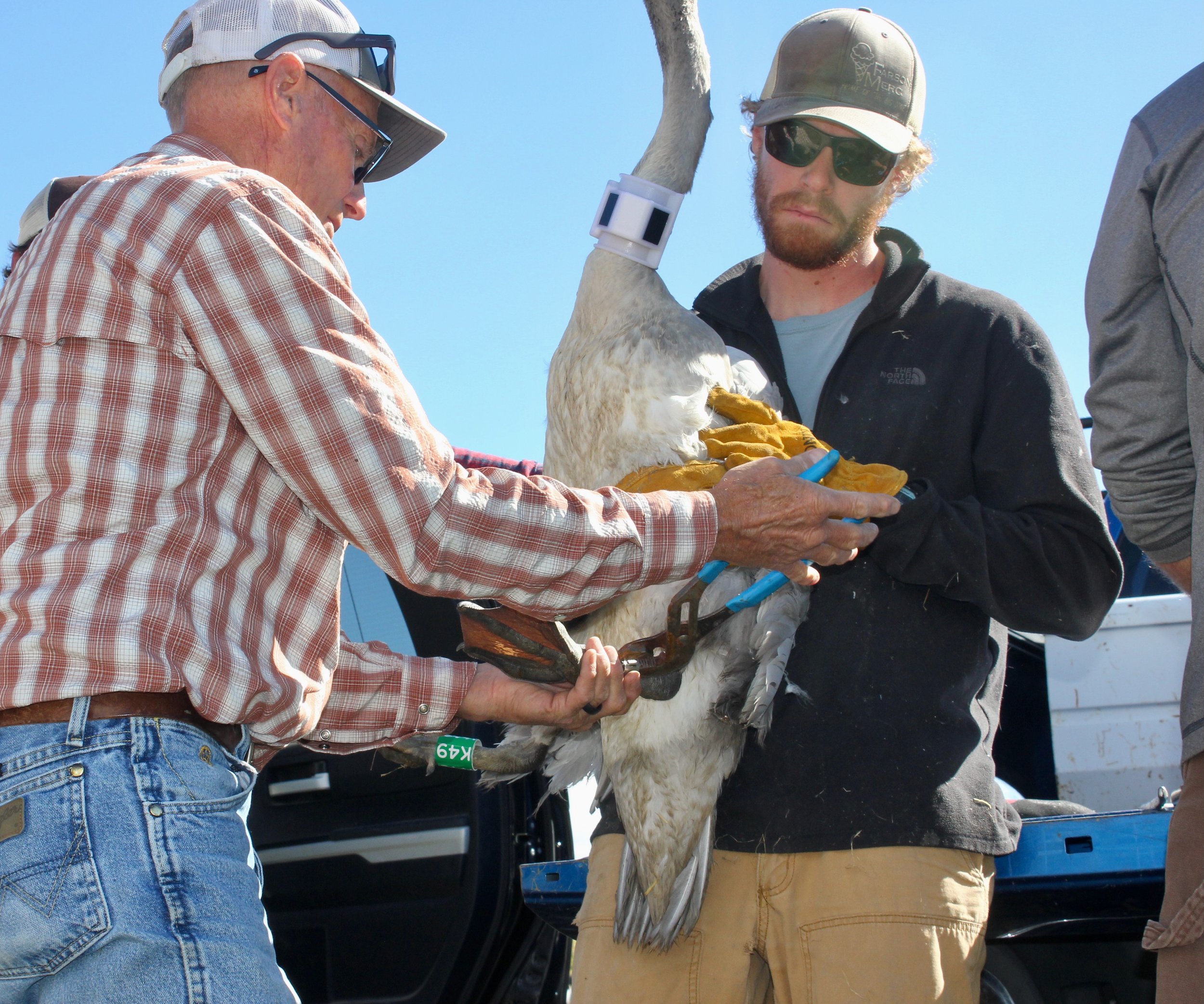
Restoring Greater Yellowstone Trumpeter Swans
Why Trumpeter Swans?
Once considered abundant and geographically widespread, Trumpeter Swan numbers and distributions were greatly reduced during the early fur trade and European settlement (1600's-1800's). Swan skins and feathers were used in popular products such as ladies’ powder puffs, fashionable hats, and ink pens. The dramatic reduction of beaver numbers due to trapping also caused swans to lose habitat without the ecological engineers who helped maintain healthy wetlands. In 1932, only 69 Trumpeter Swan individuals were documented in the Greater Yellowstone Ecosystem in Wyoming, Idaho, and Montana. Since then, numbers have increased due to protection from hunting, habitat preservation, and restoration programs. However, many threats to their recovery still exist, including habitat loss, power line strikes, poaching, accidental hunting take, lead poisoning, disturbance of nest sites, competition for limited resources, reduced migration in several wild and restored flocks, and threats of genetic bottlenecking.
Captive Breeding Program
Despite being driven to near extinction, the resident Greater Yellowstone population has rebounded to about 550 Trumpeter Swans. Wyoming Wetlands Society was established in 1986 to supplement wild populations with a captive breeding program. Many of the Trumpeter Swans in the breeding program are birds that were injured from power line strikes, lead poisoning, or other debilitating injuries that prevented them from being re-released. Thanks to the generosity of private landowners and donors we now have 7-8 breeding pairs in Jackson Hole that can produce upwards of 30 cygnets per year for release.
Research
Recently, WWS initiated a project with state and federal partners to GPS collar Trumpeter Swans with the aim of studying their migration patterns and habitat use. This technology has provided some important insight into how Wyoming swans move during the year, what wetland habitats are used, and migration routes. This data helps to understand which areas are important to manage in order to provide habitat for an expanding swan population. Trumpeter swans are a Species of Special Concern in Wyoming and their resiliency is important to the long term survival of the species.
Trumpeter Swan Releases
Our release sites in Idaho, Wyoming, and Montana are in areas that once had healthy Trumpeter Swan populations and are still suitable for swans. These sites are on the fringe of the current range and occupied habitat of wild swans. Sites need to be approved by the Greater Yellowstone Trumpeter Swan Working Group, in coordination with the Pacific Flyway Council.
Since 1986, we have released over 800 swans in the GYE!
Project Locations
Bear Lake, ID: Since 2002, 27 Swans have been released. Commonly, 2 to 3 nesting pairs can be observed on the Refuge.
Big Sandy, WY: WWS and Wyoming Game and Fish Department initiated the Big Sandy Swan Range Expansion Project in July of 2024 to establish alternate migration patterns to wintering areas south of Wyoming. The first release was completed this last month ( July 2024) with the release of 5 yearling trumpeter swan and all the birds were marked with GSM tracking devices to monitor movements and their fall migrations. An additional 6 swans will be released this fall for the 2024 release. This ten-year project will complete Wyoming’s efforts with a tentative completion date in 2034.
Blackfoot Valley, MT: Since 2005, 213 Swans have been released. The program reached a milestone in 2011 when 2 pairs fledged 7 cygnets, the first successful nesting attempt in over 100 years. The program has met its goal with 7 nesting pairs fledging young for 2 consecutive years.
Green River, WY: This was the first Wyoming release that began in 1994. In the years following, some 75 swans were released, resulting in over 30 territorial pairs and 15 nesting pairs by 2018.
Madison Valley, MT: This project started in 2012 with a goal of 5 nesting pairs. So far, 43 swans have been released; no nesting has been observed yet, but young families have been seen there in the early spring.
Salish and Kootenai Tribe, MT: The first Montana release, WWS released 120 swans. The Salish Kootenai project is considered completed, with 11 nesting pairs and other pairs on the fringe of the Reservation including Glacier National Park.
Summer Lake, OR: Since 2009, 150 Swans have been released. Releases will occur annually until goals of 10 nesting pairs and/or 50 adult swans in the survey are met.
Teton Basin, ID: Initiated in 2013, this project’s goal is 2 to 3 nesting pairs. 39 swans have been released to date, with 1 young pair established so far.
Wind River Reservation, WY: This project was initiated in 2013 with the release of 5 cygnets. In 2018, one of those birds nested and was the first nesting swan on the Reservation in over 150 years.
Yellowstone National Park (YNP), WY: WWS is the only captive breeding program permitted to release swans in the Park due to rigorous genetic standards, and have released over 60 swans there since 2012. The swan population had been declining (down to about 2 birds by 2010), along with nesting and fledging success, but current numbers are up to 27 with about 7 territorial pairs observed each year. Five pairs nested last year and 3 produced young; it is expected that new pairs will be coming on line in the near future.






